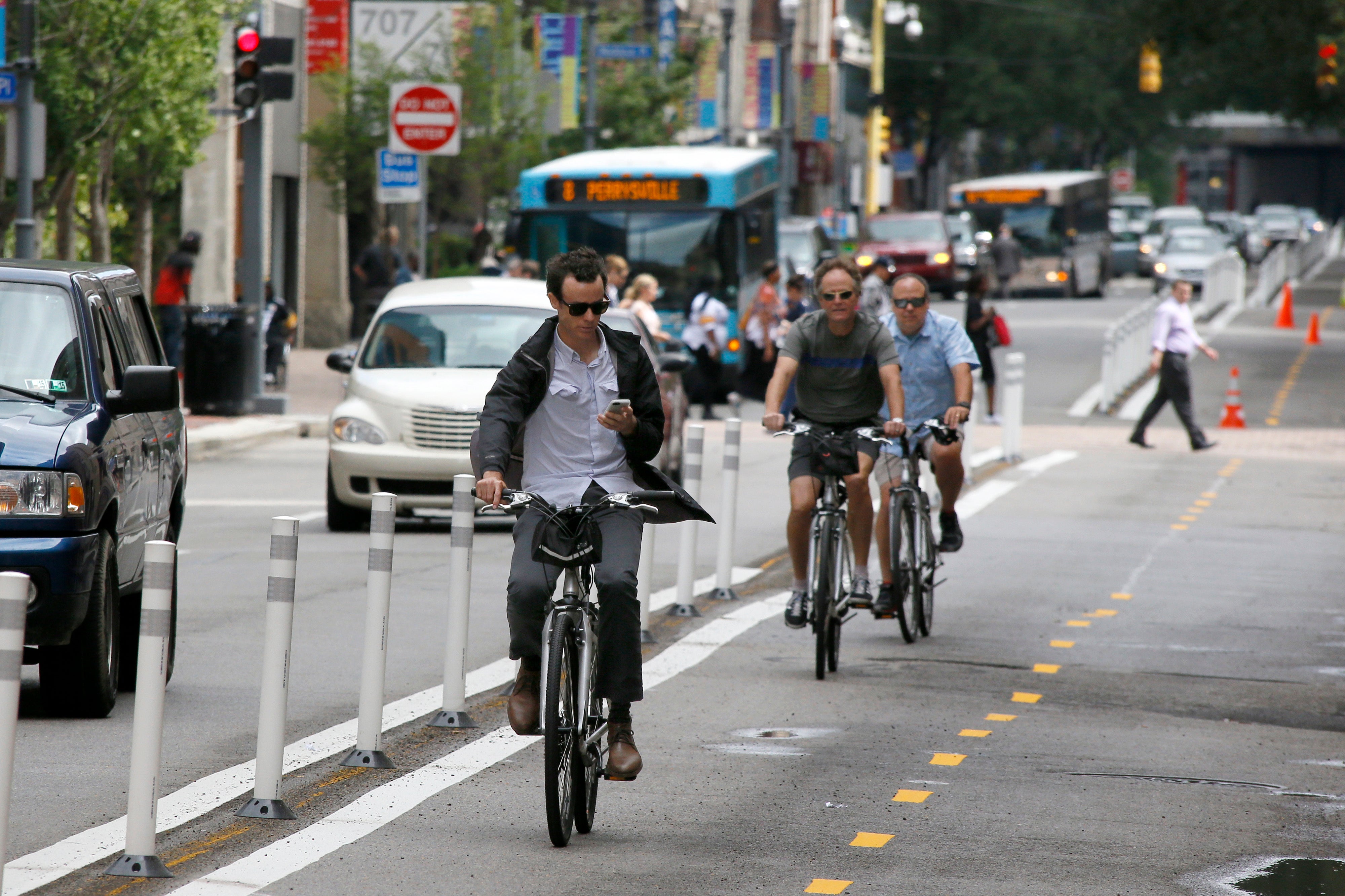Ideas Worth Stealing: The Idaho stop

Bicyclists pedal on a bicycle-only lane on Penn Avenue in downtown Pittsburgh. (AP Photo/Keith Srakocic)
Let bicyclists roll through stop signs when there is no traffic.
Many bicyclists, especially in urban areas, choose to ride on side streets because they feel safer. After all, there are no cars whizzing past you at 40 miles per hour, and there are fewer pedestrians and errant car doors to deal with. No surprise, then, that many towns and cities put their “bike routes” on these same streets.
Unfortunately, there’s a problem: these quieter streets tend to be punctuated — every block or two — with stop signs.
Stop signs are a mild nuisance to cars, necessitating a foot shift from the gas to the brake and then back again. But when bicyclists are forced to come to a stop, they lose all of their hard-fought momentum. One study by a physics professor found that coming to a complete stop and restarting pedaling takes 25 percent more energy than slowly rolling through the sign.
Fortunately, there is a better way. It is called the “Idaho stop.”
Back in 1982, Idaho passed a law that said bicyclists can treat stop signs as “yield signs” when there is no other traffic at the intersection. So, if you’re on a bicycle and arrive at a four-way stop and there are no motorists stopped at the intersection, you’re legally allowed to — safely — roll through the stop sign and continue on your way. (The video below has a good visualization of how it works.)
“The basic thing that makes it attractive is that when you’re bicycling, you’re using your energy and your muscles,” says Ken McLeod, the state and local policy manager for the League of American Bicyclists. “And the Idaho stop often allows you to conserve that energy and safely go through an intersection without coming to a full stop and losing all of our momentum.”
To be clear: This does not mean bicyclists are allowed to blow through any and all stop signs, especially if there are cars on the road. It simply makes it legal to do what many bicyclists — and for that matter, motorists — already do: roll through stop signs when there’s no one else around. (When it comes to red lights, Idaho requires bicyclists to come to a complete stop; if there is no traffic, they are allowed to proceed throught the light.)
But is the Idaho stop safe?
An immediate and obvious concern is the whether those traffic rules will result in more bicyclists being hit by cars. Many bicyclists ride extremely defensively (read: carefully) when riding on city streets, well aware that they’re incredibly fragile compared to cars and trucks.
We also have a more than 30 years of traffic safety data from Idaho. Researcher Jason Meggs conducted a study with the University of California Berkeley School of Public Health looking at the Idaho data and found, as he writes, “There was absolutely no indication that the Idaho Law had caused any harm.” When Meggs compared bicycle accidents in Boise, Idaho and Sacramento, California — two similar cities — he found Boise had at least 30 percent fewer injuries.
More recently, a few towns in Colorado, including Aspen, Breckenridge, and Dillon enacted Idaho stop laws. They, too, haven’t seen a rash of problems.
“[Overall], there has been no report of dramatic rises in serious injuries or fatalities,” McLeod says. “The comparisons that have been done didn’t show any real discernable effect of the Idaho stop on really any safety statistics that would commonly be used to evaluate whether a transportation system is safe or not.”
Can it possibly work in Pennsylvania?
The entire state of Idaho only has 1.65 million residents, which pales in comparison to Pennsylvania’s 12.8 million. Philadelphia alone, in fact, has about the same population as the entire state of Idaho.
But Boise is bigger than you might think, with 216,000 residents. It’s smaller than Philadelphia, sure, but big enough that it’d be the third largest city in Pennsylvania, well ahead of Allentown and Erie.
Considering that the law is working just fine in Boise means that it could be worth a try here, too, to encourage more people to use bicycling as a means of transportation (which has myriad benefits on traffic, health, and the environment).
McLeod, for his part, didn’t recommend a wholesale change to state law. “I think it’d be great to see more places experiment with ways to partially enact the Idaho stop where it is appropriate or more likely to be safe,” he says. “It doesn’t have to be everyone in Pennsylvania has the Idaho stop law or nobody does — it’d be really cool to see more incremental approaches to the rule.”
WHYY is your source for fact-based, in-depth journalism and information. As a nonprofit organization, we rely on financial support from readers like you. Please give today.



